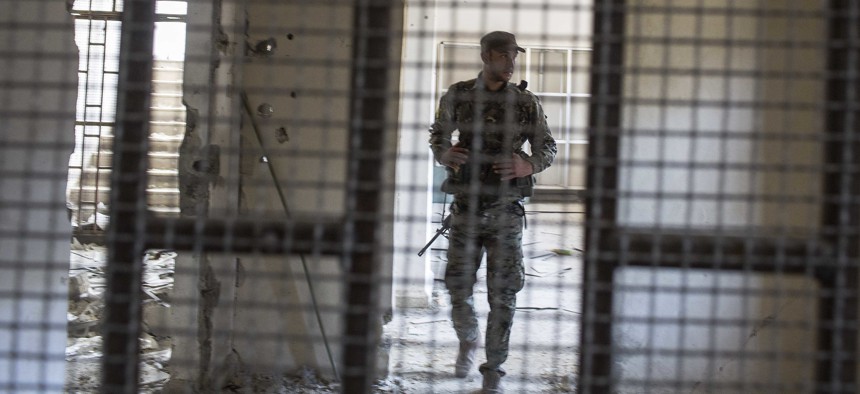
A Syrian Democratic Forces fighter in the liberated soccer stadium-turned-prison where ISIS held locals, Raqqa, Syria, Friday, Oct. 20, 2017. Now, SDF is holding captive 'hundreds' of ISIS foreign fighters. Photo/Asmaa Waguih
US-Backed Syrian Force Holding ‘Hundreds’ of ISIS Foreign Fighters
A day after CENTCOM'S leader says they should face prosecution at home, Trump hints at Gitmo option.
AMMAN, Jordan – The top U.S. commander of forces in the Middle East, Gen. Joseph Votel, predicted on Monday that “hundreds” of ISIS foreign fighters captured by U.S.-backed Syrian forces would be sent back to their home countries for prosecution.
But on Tuesday, President Donald Trump said in his State of the Union address that he was working to keep the option to detain enemy combatants in military prisons, instead of prosecuting them in the criminal justice system.
Which is it? To detain? Or to prosecute? It’s a question that has hounded U.S. leaders since the post-9/11 wars began. But the ISIS war is a bit different. In Iraq, the U.S. has handed some ISIS prisoners to the government for trial. In Syria, the U.S. chose to bypass the regime and build a local, separate anti-ISIS force to do the fighting and the capturing. But U.S. leaders never have set a formal, public policy about what to do with enemy fighters captured by U.S. or U.S.-aligned local forces in Syria, yet not held directly by the American military. (Combatants, or high-value targets, snatched by intelligence agencies are a whole different matter.) It’s a muddy system by design, intended to allow the U.S. to avoid politically dirty questions about holding foreign terrorists and fighters indefinitely in military prisons such as the one at Guantanamo Bay, Cuba. But it also raises a new question: What legal and moral responsibility, if any, does the United States have regarding the detention and fate of prisoners taken by U.S.-led, -built, -trained, and -equipped local forces?
“Syrian Democratic Forces in Syria have done a really good job of picking up foreign fighters as they begin to move, and putting them into their detention. So we can begin to look for ways to get them back to their home countries for prosecution,” U.S. Central Command’s Gen. Joseph Votel said Monday.
Votel made the comment after reporters asked him what he expects of ISIS’s future. (He was not being asked about Trump or responding to Trump’s yet-to-be-announced decision on Guantanamo.) In Iraq, he said, coalition troops and security forces have been sweeping already-liberated areas like Mosul, Fallujah, and Ramadi to “root out” any potential insurgent cells and remnants of the organization, with success. In Syria, the SDF has also captured alleged ISIS fighters. How many? “Hundreds,” he replied.
One day later, Trump signed an executive order to keep open the notorious U.S. military prison at Guantanamo, in order to preserve the U.S. ability to hold enemy combatants separate from the civilian judicial process.
In his speech to Congress, Trump also revealed he has asked Defense Secretary Jim Mattis to look into military prisons, but made it clear his administration intended to use Guantanamo. That would be a reversal of the previous eight years under President Obama, who worked hard to shrink the prison population there.
“Terrorists who do things like place bombs in civilian hospitals are evil. When possible, we have no choice but to annihilate them,” he said. “When necessary, we must be able to detain and question them. But we must be clear, terrorists are not merely criminals, they are unlawful enemy combatants and when captured overseas, they should be treated like the terrorists they are.”
“In the past, we have foolishly released hundreds and hundreds of dangerous terrorists, only to meet them again on the battlefield,” the president continued, “including the ISIS leader, al-Baghdadi, who we captured, who we had, who we released.”
Those statements quickly were evaluated by fact-checkers as “mostly false.” “Trump’s ‘hundreds and hundreds’ is really 122 combatants spread out over 15 years,” the group Politifact argued, though that’s only if one counts prisoners at Guantanamo. Baghdadi was never held in Guantanamo, he was held at a U.S. military camp in Iraq. He was not released by the U.S.; he was transferred to the Iraqis, who later released him.
Still, Trump continued, “I just signed, prior to walking in, an order directing Secretary Mattis — who is doing a great job, thank you — to reexamine our military detention policy and to keep open the detention facilities in Guantanamo Bay. I am asking Congress to ensure that in the fight against ISIS and al-Qaeda we continue to have all necessary power to detain terrorists wherever we chase them down, wherever we find them. And in many cases, for them, it will now be Guantanamo Bay.”
Again.
Where are the ISIS fighters? Where are all the detainees? That’s the question many have asked throughout the ISIS war. Throughout the war there have been mixed, and unverified, reports of prisoner releases, allegations of torture, and families searching for missing relatives. SDF leaders said last fall they were putting many captured ISIS leaders through trials and would expel them to their countries. But what trials? Where? And will their home countries agree to the SDF rulings or decide their own fates for the returning captives?
Trump’s announcement, if believed, means the U.S. expects to take in more terrorists as enemy combatants and wants to begin using Guantanamo. Certainly there has been an increase in counterterrorism missions across Centcom and Africa that could result in many more prisoners. But Votel clearly had different expectations for those ISIS members already detained by America’s proxy, the SDF, in Syria. How they will move from Syria back to their home countries, and who tracks their fates, remains to be seen. But it falls to the Pentagon once again to explain and defend its detention policies for this latest phase in the global, transnational, and muddy war on terrorism.




